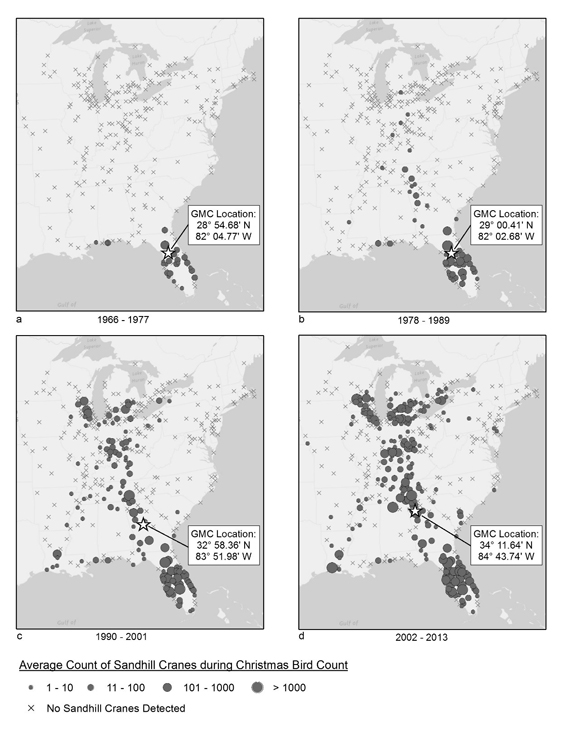“The sadness discernible in some marshes arises, perhaps, from their once having harbored cranes. Now they stand humbled, adrift in history” ~ Aldo Leopold, Marshland Elegy
 A century ago, Sandhill Cranes nearly disappeared from the eastern half of the United States, leading writer and ecologist Aldo Leopold to lament the great loss of cranes in Wisconsin marshes. Sandhill Cranes are now abundant in much of the eastern United States, in part due to habitat protection and the end of unregulated hunting. To understand how the distribution of Sandhill Cranes has changed, researchers at the International Crane Foundation used data from almost fifty years of public data from two annual surveys, the Christmas Bird Count and North American Breeding Bird Survey, to delineate changes in the crane’s wintering and breeding areas. We were surprised to see the dramatic changes in the population’s distribution.
A century ago, Sandhill Cranes nearly disappeared from the eastern half of the United States, leading writer and ecologist Aldo Leopold to lament the great loss of cranes in Wisconsin marshes. Sandhill Cranes are now abundant in much of the eastern United States, in part due to habitat protection and the end of unregulated hunting. To understand how the distribution of Sandhill Cranes has changed, researchers at the International Crane Foundation used data from almost fifty years of public data from two annual surveys, the Christmas Bird Count and North American Breeding Bird Survey, to delineate changes in the crane’s wintering and breeding areas. We were surprised to see the dramatic changes in the population’s distribution.
 What did we find? The total number of Sandhill Cranes counted in the eastern United States during late December Christmas Bird Counts grew from 423 in 1965–1966 to 46,194 in 2012–2013, with a peak number of 55,826 in 2011–2012. The majority of wintering Greater Sandhill Cranes were located in Florida from 1966 to 1989, but shifted north-northwest into Georgia by 1990–2001. By 2002–2013, the core had shifted further northwest – essentially, the birds were “short-stopping,” or wintering in locations further north on the flyway (see image).
What did we find? The total number of Sandhill Cranes counted in the eastern United States during late December Christmas Bird Counts grew from 423 in 1965–1966 to 46,194 in 2012–2013, with a peak number of 55,826 in 2011–2012. The majority of wintering Greater Sandhill Cranes were located in Florida from 1966 to 1989, but shifted north-northwest into Georgia by 1990–2001. By 2002–2013, the core had shifted further northwest – essentially, the birds were “short-stopping,” or wintering in locations further north on the flyway (see image).
What does this mean for the future? Sandhill Cranes in the eastern United States may continue to winter further north and remain in more northerly areas later in the fall before migrating further south (click here to read our article in The Bugle, “Should I Stay or Should I Go”). Factors such as annual weather variations, long-term climate change, and changes in our land use may all interact to produce these changing patterns. The next time you see Sandhill Cranes, take a moment to consider what they may be telling us about our changing landscapes.
Read the paper’s full abstract published in the Journal of Field Ornithology: Changes in the number and distribution of Greater Sandhill Cranes in the Eastern Population.

 Story submitted by Anne Lacy, International Crane Foundation Crane Research Coordinator, and Dorn Moore, Geospatial and Information Services Manager. Learn more about our North America and Global Headquarters programs.
Story submitted by Anne Lacy, International Crane Foundation Crane Research Coordinator, and Dorn Moore, Geospatial and Information Services Manager. Learn more about our North America and Global Headquarters programs.
